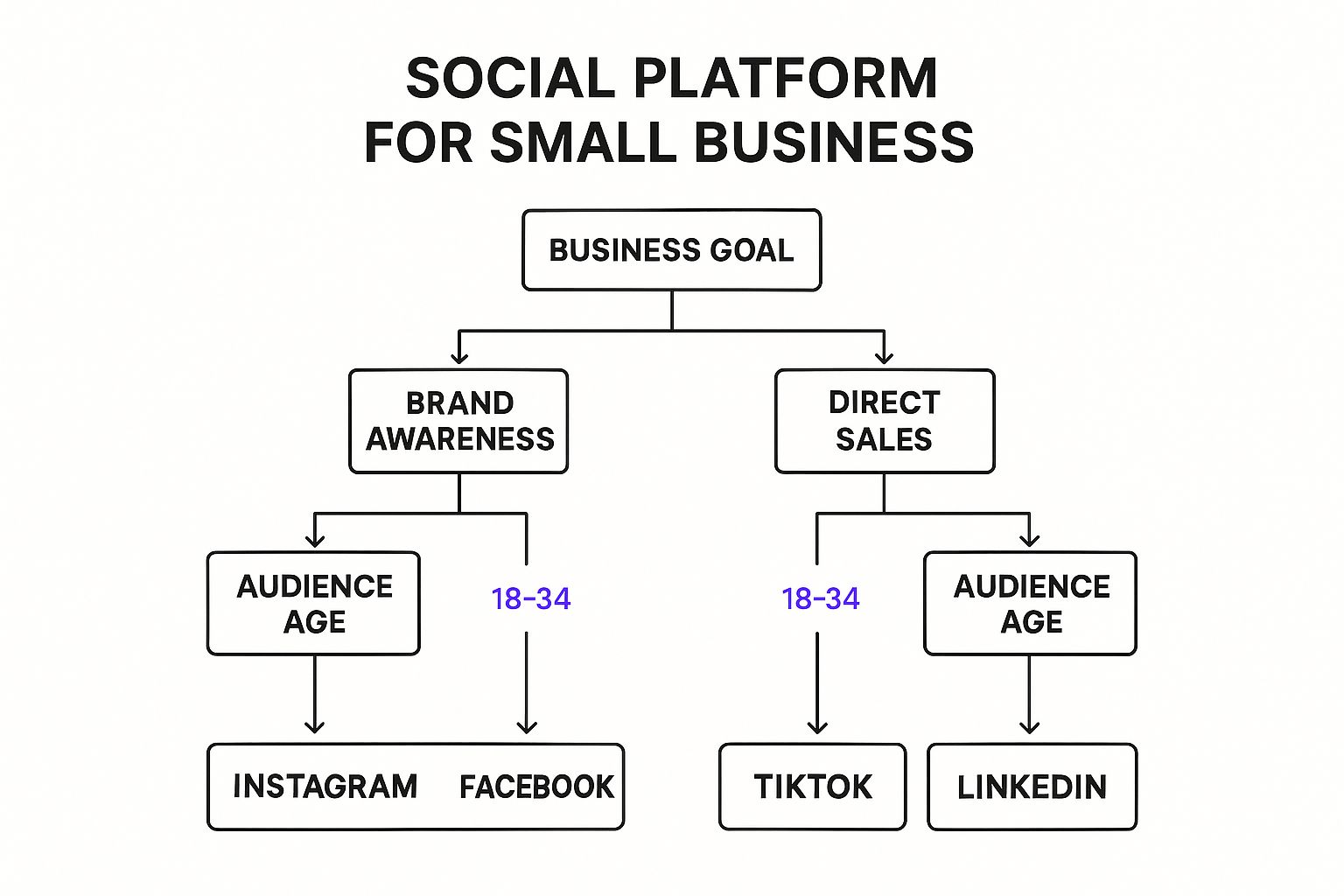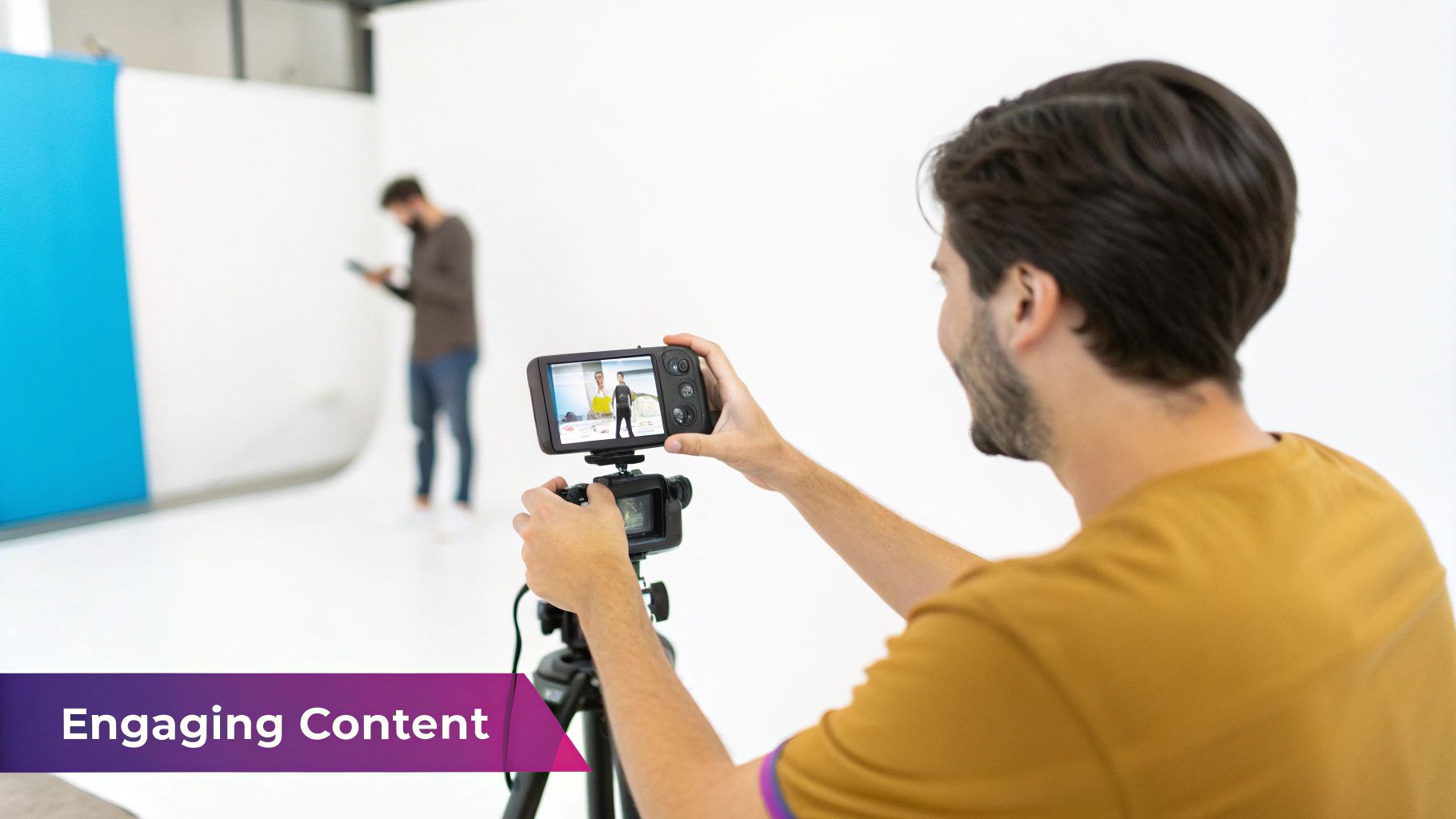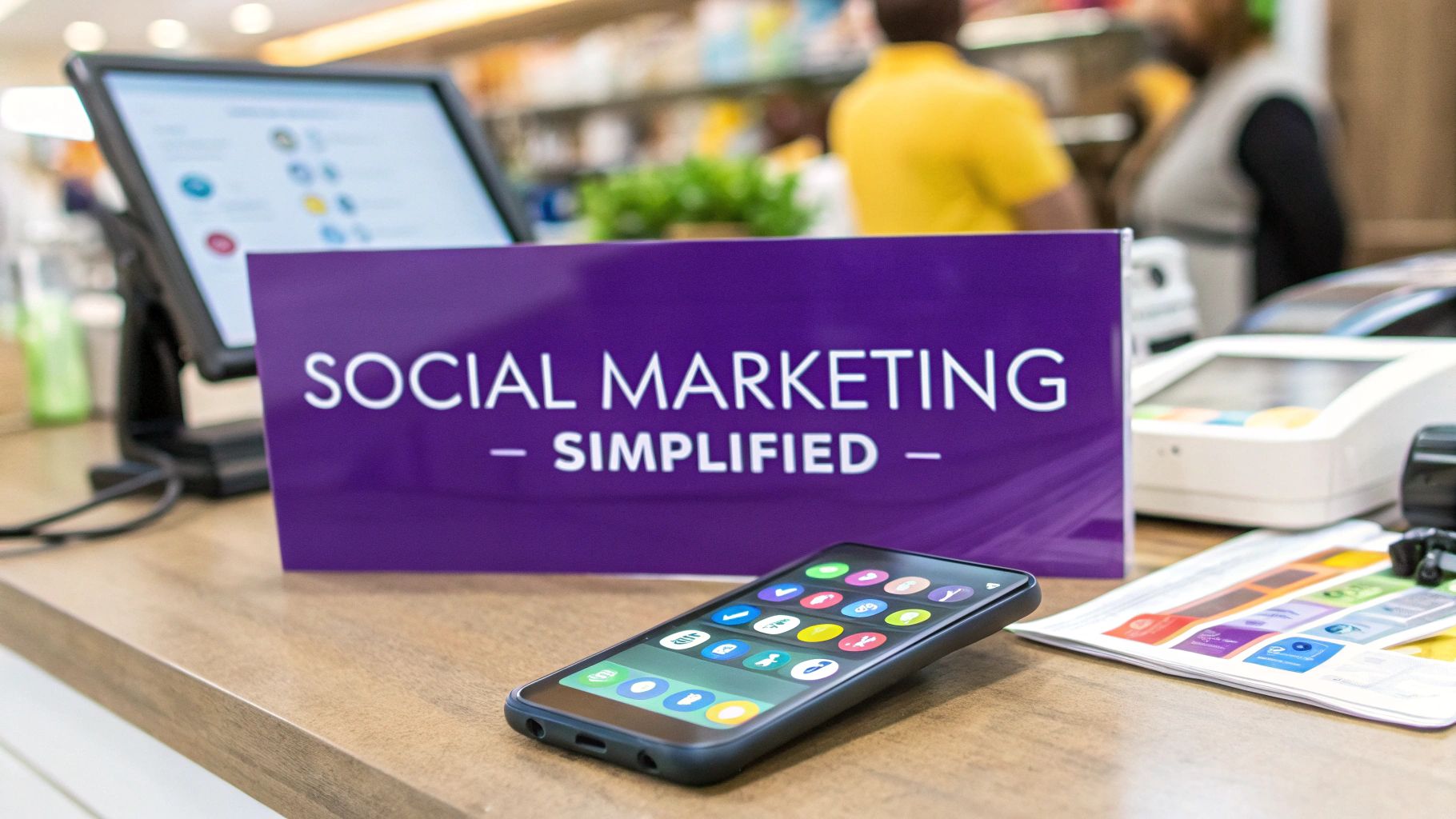Social Media Marketing for Small Business Simplified
Social media marketing for a small business isn't just another box to check on your to-do list. It’s the new town square, the modern main street where your customers hang out, discover new brands, and decide who they want to support. It completely changes the game, letting you connect directly with your audience, build a real community, and grow your business without needing a massive marketing budget.
Why Social Media Is Your Digital Main Street

Think about the classic main street storefront. You'd greet familiar faces, chat with people walking by, and become a trusted part of the neighborhood. Those daily interactions build relationships that keep people coming back. That's exactly what powerful social media marketing for small business does, just on a global scale.
It’s your digital welcome mat, a community hub, and a direct line to the people who will make or break your success. We're talking about a place where an incredible 4.95 billion people gather. Data shows that six out of ten users are actively discovering new brands and products right there on their feeds. For a small business, this is a golden opportunity to get seen and heard.
Building Connections That Actually Mean Something
Traditional advertising is a one-way street—you shout a message and hope someone listens. Social media is a two-way conversation. It’s where you get to share your story, show off the real people behind the curtain, and—most importantly—listen to what your customers are actually saying.
This kind of direct engagement builds something far more valuable than a quick sale: it builds trust. When your customers feel seen and heard, they don’t just buy from you once. They become loyal fans who tell their friends.
Punching Above Your Weight Class
Not too long ago, competing with big corporations and their bottomless marketing budgets was a pipe dream. Social media flips that script entirely. Success isn't just about who can spend the most; it's about who connects the best.
A local coffee shop can build a more passionate, loyal following than a national chain just by sharing behind-the-scenes moments, featuring their regular customers, and personally replying to every single comment. Your authenticity is the one thing they can't buy.
This guide is your roadmap. We’re skipping the fluff and the jargon to give you practical, actionable strategies built for the reality of running a small business—where time is tight, budgets are small, and you need results you can actually see. You're going to learn how to:
- Listen to your audience to figure out what they really want.
- Share your unique story to build a brand people remember.
- Engage with your community to create die-hard fans.
- Drive real growth that shows up on your bottom line.
Choosing Where to Build Your Online Presence
Jumping into social media for your small business feels like walking into a massive, noisy food court. Every vendor is shouting for your attention, but you've only got the budget—and the stomach—for one or two spots. You could try to sample a little bit of everything, but you'll just end up overwhelmed and unsatisfied.
The smart move? Pick the vendor where you know your people are already lined up.
Choosing a social media platform is a lot like that. It's not about being everywhere; it's about being in the right places. Think of it like setting up a physical shop. You wouldn't open a high-end boutique in a discount outlet mall, nor would you launch a skate shop in a retirement community. You go where your ideal customers already hang out.
Match Your Platform to Your People
First things first: get crystal clear on who you're trying to reach. Different platforms attract wildly different crowds. Trying to sell B2B consulting services on a platform dominated by teenagers is a recipe for crickets and wasted ad spend.
Your audience's demographics and online habits are your compass. A recent analysis shows that while a giant like Facebook still has a broad user base, younger audiences are flocking to more visual, fast-paced apps.
- For a Younger Audience (Gen Z & Millennials): Platforms like TikTok and Instagram are king. These are visual-first playgrounds where short-form video, authentic stories, and influencer collaborations thrive. A local clothing boutique or a trendy new cafe would feel right at home here.
- For a Broader Adult Audience (Gen X & Boomers): Facebook remains a powerhouse. Its strength is in building tight-knit communities through Groups, sharing detailed business updates, and running hyper-targeted local ads. A home renovation contractor or a local insurance agent would find this platform incredibly valuable.
- For Professionals and B2B Services: LinkedIn is the undisputed leader. Think of it as the world's biggest professional networking event, happening 24/7. It’s perfect for sharing industry insights, connecting with other business owners, and establishing yourself as an expert. Accountants, consultants, and software companies absolutely crush it on LinkedIn.
Align Your Content With the Platform's Vibe
Once you know who you're talking to, you have to figure out how you'll talk to them. Every platform has its own unspoken rules and content style. A brilliant, witty post on Instagram might fall completely flat on LinkedIn.
The core principle is simple: Don't force your content to fit a platform. Instead, choose a platform that naturally fits the kind of content your business already creates. This alignment is what separates effective social media marketing from just making noise.
For example, a bakery’s mouth-watering photos of cakes and pastries are a perfect match for Instagram's visual feast. A law firm, on the other hand, would get way more traction sharing insightful articles and professional updates on LinkedIn.
To simplify this, here's a quick-glance matrix to help you map your business to the right platform.
Platform Selection Matrix for Small Businesses
| Gen Z, Millennials (18-34) | High-quality visuals, Reels, Stories, influencer content | Brand awareness, product discovery, e-commerce sales | |
|---|---|---|---|
| Gen X, Boomers (30-65+) | Community building (Groups), local updates, event promotion, ads | Local lead generation, customer relationships, broad reach | |
| TikTok | Gen Z (16-24) | Short-form video, trends, user-generated content, humor | Viral brand awareness, reaching younger demographics |
| Professionals, B2B decision-makers (25-55+) | Industry articles, company news, case studies, professional insights | B2B lead generation, establishing authority, recruitment | |
| Millennial women (25-40) | How-to guides, infographics, product discovery, visual inspiration | Driving website traffic, e-commerce sales (visual products) | |
| X (Twitter) | Broad (news junkies, tech, media) | Real-time updates, quick commentary, customer service, news | Brand voice development, real-time engagement, PR |
This table isn't gospel, but it's a solid starting point. Your specific niche might have a unique presence somewhere unexpected, so always do your own recon before committing.
The infographic below offers another way to visualize this decision, guiding you from your primary business goal to the most suitable platform.

This visual guide shows how your goals—whether it’s building brand awareness or driving direct sales—and your target audience's age can point you directly to the best starting platform for your business.
Start Small and Master Your Niche
The single biggest mistake small businesses make is spreading themselves too thin. It's far better to master one or two platforms than to have a mediocre, ghost-town presence on five.
Choose your primary platform based on your audience and content style, and dedicate your energy to building a real community there. Once you've got momentum, you can think about expanding. You can also explore the power of social media advertising to hit the gas on your growth. This focused approach ensures your efforts deliver a real return instead of just adding to the digital noise.
Creating Content That Connects and Converts

Alright, you’ve picked your platforms. Now for the million-dollar question: what on earth do you post? Let’s get one thing straight—great social media content isn't a megaphone for shouting “BUY MY STUFF!” It’s a magnet.
Your goal is to start conversations, solve tiny problems, and build a genuine relationship long before you ever ask for a sale. This isn't about chasing every fleeting trend; it’s about building a solid foundation so you never have that "what do I post today?" panic again.
Establish Your Content Pillars
Think of content pillars as the three to five core themes your brand will own. These are the main support beams of your entire content strategy, ensuring everything you create is relevant, valuable, and directly tied to what you do best. They keep you focused.
Let's say you're a freelance financial consultant. Your pillars might look something like this:
- Small Business Budgeting: Actionable tips on managing cash flow. No fluff.
- Tax Season, Demystified: Breaking down complex tax laws into plain English.
- Investing for Beginners: Simple, educational content for building long-term wealth.
- Client Success Stories: Real-world proof that your advice gets results.
Sticking to these themes means you’ll consistently attract the exact people you want to help: small business owners craving financial clarity.
The Three Types of Content That Actually Build Trust
With your pillars in place, it’s time to create. But not all content is created equal. To build a loyal following, you need a healthy mix of posts that teach, connect, and prove your worth.
Educational Content That Solves Problems
Your audience is scrolling for answers. Become their go-to resource by giving away your expertise. Create quick "how-to" videos, share checklists, or write short posts that solve a common pain point. This positions you as a trusted guide, not just another seller.
Behind-the-Scenes Glimpses That Show You're Human
People connect with people, not faceless logos. Pull back the curtain and show the real side of your business. Share a video of your team packing an order, a photo of your messy desk, or a story about a challenge you overcame. This kind of authentic content is relatable and builds a genuine bond.
Customer Stories That Provide Social Proof
Nothing sells your service better than a happy customer. Feature testimonials, share user-generated content (with their permission, of course!), or post a quick case study. When potential customers see others like them winning with your help, it builds powerful trust almost instantly.
Follow the 80/20 Rule for Sustainable Engagement
Now for the golden rule. It’s simple but incredibly powerful: 80% of your content should provide pure value, and only 20% should be promotional.
Imagine going to a party where someone only talks about their job and tries to sell you something. You'd find a reason to leave, fast. Social media is the exact same. Your feed should feel like a valuable, interesting place to hang out, not a constant sales pitch.
This means for every five posts, four should be designed to educate, entertain, or inspire. The fifth can be your direct ask—promoting a sale, launching a new product, or asking people to book a call. This balance keeps your audience engaged and makes them far more receptive when you do have something to sell.
And the data backs this up. By 2025, social media marketing for small businesses is a non-negotiable channel, with roughly 90% of small businesses using these platforms in their strategies. This is all because of the massive shift to digital, where 78% of shoppers now research products on social media before they even think about buying. You can find more insights like this in the 2025 Social Media Marketing Industry Report on socialmediaexaminer.com.
By creating content that serves your audience first, you're not just making posts. You're building a community that trusts you, values what you have to say, and will be ready to buy when the time is right.
How to Build a Thriving Online Community
Putting out great content is like setting up a beautiful storefront window—it gets people to stop and look. But if you never actually open the door to chat, they’ll just keep walking. The real secret to social media marketing for a small business is turning those casual window shoppers into a loyal, tight-knit community.
Think of yourself as the host of an amazing party. You wouldn't just put out snacks (your content) and then go hide in the kitchen, right? Of course not. You’d greet people at the door, introduce them to each other, and make sure everyone feels like they're part of something special.
This is the jump from being a content creator to a community builder, and it’s where the magic really happens. It’s what turns passive followers into passionate fans who will cheer you on, defend your brand, and become your best source of word-of-mouth referrals.
From Monologue to Dialogue
The first rule of community building is painfully simple: stop talking at your audience and start talking with them. Social media was built for two-way streets, not one-way broadcasts. Your job is to get the conversation started.
Treat your comments section like gold. When someone takes the time to leave a comment, they're raising their hand and asking to connect. Responding isn’t just good manners; it's a strategic move that proves you're listening and that their opinion actually matters. Even a quick, "Thanks so much, we're glad you liked it!" makes a customer feel seen.
A recent study found that 41% of consumers feel more positive about brands that actually engage with them on social media. Promptly and personally responding to comments is one of the lowest-effort, highest-impact things you can do.
Don't just wait for them to talk, though. Actively invite them into the conversation. End your captions with open-ended questions that get people sharing their own stories, opinions, or ideas. Don’t let your post be a dead end.
Sparking Engagement with Interactive Content
Static posts are fine, but interactive content is what makes people lean in and participate. Luckily, social media platforms are packed with tools designed to pull your audience into the story.
- Run Polls and Quizzes: Use Instagram Stories or X (formerly Twitter) polls to ask fun, relevant questions. A local coffee shop could ask, "Is today a hot latte or iced coffee kind of day?" It’s a dead-simple way to get a click and learn something about your followers' preferences.
- Go Live for Real-Time Connection: Hitting that "Go Live" button can feel intimidating, but it's one of the most powerful ways to build genuine connection. Host a live Q&A session, give a behind-the-scenes tour of your workspace, or unbox a new product. The unscripted, raw nature of live video builds a ton of trust.
- Create Content That Begs to Be Shared: Think about what makes you hit the "share" button. It’s usually a funny meme that hits close to home, an inspiring quote, or a super helpful checklist. When your content gets shared, your community does your marketing for you.
Turning Customers into Your Best Marketers
Your happiest customers are your most powerful secret weapon. User-generated content (UGC) is the digital version of word-of-mouth, and it’s wildly persuasive because it comes from real people, not your brand’s marketing department. Your job is to encourage it and celebrate it.
Start by creating a unique brand hashtag and encouraging customers to use it when they post photos with your product. A local plant shop, for example, could start #MyLeafyHome and feature the best customer photos on their feed every Friday.
This approach hits two birds with one stone. First, it gives you a constant stream of authentic, relatable content to post. Second, it gives your customers a moment in the spotlight, making them feel like a valued part of your brand's story. This cycle of sharing and recognition is the engine that drives a truly thriving online community.
Balancing Organic Growth with Paid Advertising

So far, we’ve been talking about earning your audience’s attention. This is the heart and soul of organic social media growth—the slow-burn process of building a reputation with killer content and real community chats. Think of it as digital word-of-mouth. It’s authentic, powerful, and builds the kind of trust that lasts.
But let’s be real. Relying only on organic reach can feel like whispering in a hurricane, especially when you’re the new kid on the block. The algorithms are crowded, and getting your message in front of fresh eyes takes a ton of time and consistency.
That's where the other side of the coin comes in.
Paid Advertising: Your Growth Accelerator
If organic growth is the marathon, paid advertising is the sprint. It’s your shortcut, letting you bypass the slow build and drop your message right in front of a hand-picked audience. You’re not just hoping the right people see your content; you’re paying to make sure they do.
For a small business, this isn't about carpet-bombing the internet with ads. It's about surgical strikes. Paid social platforms give you incredible tools to target people based on their interests, where they live, their age, and even what they do online.
This means your ad for custom wedding cakes can show up specifically for engaged couples within a 10-mile radius of your bakery. That kind of precision is what makes paid ads a crucial part of smart social media marketing for small business. You’re not just spending money; you’re investing it where it has the best shot at making you money back.
When to Open Your Wallet for Paid Ads
Throwing cash at ads without a clear mission is the fastest way to set your budget on fire. Instead, think of paid advertising as a tool you pull out for specific moments when you need a jolt of visibility.
Here are the perfect times to hit the gas:
- Launching Something New: Get immediate eyeballs on your new product or service to build momentum from day one.
- Promoting a Sale or Event: Drive urgency and traffic for time-sensitive stuff like a Black Friday deal or a local workshop.
- Boosting Your Greatest Hits: Got an organic post that's blowing up? Putting a small budget behind it can amplify its reach tenfold.
- Driving Targeted Website Traffic: When the goal is getting sign-ups for a webinar or direct sales on your site, ads are the most direct flight path.
Paid advertising shouldn't replace your organic game—it should supercharge it. A great ad can introduce hundreds of new people to your brand, but it’s your solid organic content that will convince them to stick around.
Getting Started on a Shoestring Budget
The term "ad spend" can sound intimidating, but you don't need a venture capital-sized bank account. You can start seeing results with as little as $5-$10 a day. The secret is to start small, test out different ad designs and audiences, and obsessively watch your analytics to see what’s actually working.
And you won’t be alone. Social media ad spending is rocketing upward, with global spending projected to hit a massive $276.7 billion in 2025. This explosion shows just how vital a paid strategy has become.
For small businesses that need an immediate impact, figuring out how to generate leads through paid channels is a total game-changer. You can find more practical advice in our guide on effective lead generation tactics.
Ultimately, the best strategies find a healthy balance. Use your organic content to build a loyal tribe and use paid ads to reach new customers and smash your key business goals.
Measuring Success and Proving Your ROI
Posting awesome content and watching your community grow feels great. But let’s be real: how do you know if all that hard work is actually moving the needle for your business? Just counting likes and followers—what we call vanity metrics—doesn’t tell the full story. It’s a bit like getting a round of applause but never selling any tickets.
To really get a grip on your impact, you have to connect your social media efforts directly to your bottom line.
Think of it this way: a massive follower count is like having a huge crowd standing outside your shop. It looks impressive, but if nobody ever comes inside to buy something, that crowd isn't doing you much good. True success in social media marketing for small business is about tracking how many people walk through your digital front door (click to your website) and how many of them actually make a purchase (convert). That’s how you prove your Return on Investment (ROI) and justify every minute and dollar you spend.
Key Metrics That Actually Matter
Time to ditch the vanity and focus on the numbers that show real-world business results. The good news? You don't need fancy, expensive software to get started. Every major social platform has free, built-in analytics tools that hand you all the data you need.
Zero in on these three critical areas:
- Engagement Rate: This shows how many people are actually interacting with your content (liking, commenting, sharing) compared to your total follower count. A high engagement rate is a dead giveaway that your content is hitting the mark and building a loyal community.
- Website Clicks: This one is huge. It tracks how many people clicked a link in your bio or a post to land on your website. This metric is the direct bridge between your social media world and your main business hub.
- Lead Conversions: This is the ultimate goal. It measures how many of those website visitors take the action you want them to, whether that’s signing up for your newsletter, downloading a free guide, or—the big one—making a purchase.
Using Built-In Analytics Tools
Platforms like Meta Business Suite (for Facebook and Instagram) serve up a dashboard where you can see which posts killed it, who your audience is (their demographics), and when they’re most likely to be scrolling online.
Use this data to double down on what works. If you see that short video tutorials get twice the engagement of static images, make more video tutorials. Data-driven decisions take the guesswork out of your content strategy.
The Power of Social Listening
Beyond just looking at your own numbers, social listening is your secret weapon for understanding what people are saying about your brand, your competitors, and your industry across the whole internet. It's like having your ear to the ground 24/7, catching unfiltered customer feedback and spotting trends before they blow up.
A recent survey of thousands of marketing pros found that those who use social listening are the most confident in proving their ROI. You can get the full scoop on these social media trends on hootsuite.com. By keeping tabs on keywords and conversations, you’ll uncover insights that can sharpen everything from your marketing messages to your next product idea, making sure your strategy is always on point.
Common Questions from Small Business Owners
Alright, you've got the big picture on social media strategy, but what about the nitty-gritty, day-to-day stuff? Getting started often feels like staring at a mountain of tiny, practical questions.
Let's cut through the noise and tackle the most common hurdles you'll face, from posting schedules to dealing with that inevitable angry comment.
How Often Should I Post on Social Media?
This is the big one, isn't it? The honest answer is that consistency beats frequency every single time. It's far better to show up with three amazing posts a week than to burn yourself out with seven mediocre ones. Quality builds trust; quantity just adds to the noise.
A great starting point is 3-5 high-quality posts per week on your main platform. Dig into your analytics—every platform has them for free—to see when your audience is actually online and scrolling. Schedule your best stuff for those peak times to give it the best shot at being seen.
What Are the Best Free Tools for a Small Business?
You absolutely do not need a massive budget to get started. In fact, you can run a seriously effective social media operation without spending a dime on tools. The key is knowing which freebies pack the biggest punch.
Here are a few essentials that should be in every small business owner's toolkit:
- Canva: The free version is a beast. You can design professional-looking graphics, whip up short videos, and create slick story templates without any design experience.
- Meta Business Suite: If you're on Facebook or Instagram, this is a must. It’s a free, all-in-one dashboard for scheduling posts and digging into your performance data across both platforms.
- Native Analytics: Don't sleep on the data baked right into each app! These built-in dashboards are a goldmine of information about who your audience is, which posts are hitting the mark, and when you should be posting.
How Should I Handle Negative Comments?
First, take a deep breath. It's not personal. Think of a negative comment as a golden opportunity to show everyone watching how much you care about your customers. The absolute worst thing you can do is delete it (unless it’s spammy or genuinely offensive, of course).
Address the comment publicly, promptly, and professionally. Acknowledge their issue, say you're sorry they had a bad experience, and then offer to take the conversation private via DM or email to fix it. This approach shows you're not hiding—you're solving.
Being transparent like this builds way more trust than a feed filled with nothing but five-star praise.
These answers should give you a solid foundation for the practical side of social media. For a deeper look at turning these online conversations into actual customers, check out our guide on lead generation for small business.
Ready to turn your social media presence into a powerful growth engine? The team at Rebus has the expertise to build and execute a strategy that delivers real results. Let's connect and discuss your goals.
